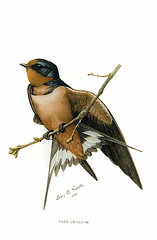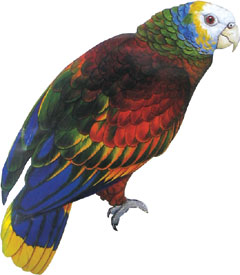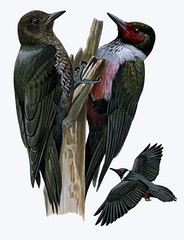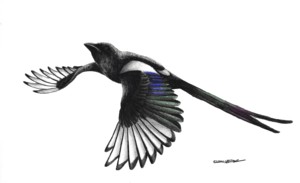Birds in the News #30

American Bittern, Botaurus lentiginosus,
captured on film in Spring 2005 by one of my
Seattle bird pals, Dawn Bailey.
Birds in Science
Oscar Wilde famously quipped that all art is useless. If he meant art in its broadest sense - including music - then some evolutionary biologists would disagree. Art and music can buy you love, or at least sex. That's especially true if you're a male bird. In many species the males not only have to sing but they have to outsing the guy in the next nest to get a mate. Marsh Warblers and nightingales have repertoires of more than 1,000 songs. For sheer survival these songs are useless - in a world of predators the males might live longer if they stayed quiet. But if you want your genes to survive into the next generation, you'd better start singing. Singing is an auditory display that signals to females a male bird is healthy and has good genes, says Nate Rice, head of ornithology at the Academy of Natural Sciences. Some male birds also imitate songs of other birds as a strategy for annexing more territory. But that goes back to the quest for sex, says Rice, since it's the bird with the biggest, fanciest home that will attract the most chicks. Additionally, for female birds, loudness matters, which explains why so many birds can project in a big way despite their small size.
 You probably thought things were pastoral out there on the farm but a new research report shows there may be all kinds of sexual escapades going on. In particular, barn swallows, Hirundo rustica (pictured), who pair up in the spring for mating, also are willing to engage in a little extramarital sex for the continuation of the species. Like many songbirds, half of all male barn swallows typically care for at least one young chick that was actually fathered by another bird, said Rebecca Safran, researcher in the Cornell University Laboratory of Ornithology and lead author of the report. Vivid color on the males may translate to health, status or ability to raise young and may be the reason that songbirds keep up appearance traits that are costly for males to maintain, Safran said. [Link to the original research paper published in the top-tier journal, Science.]
You probably thought things were pastoral out there on the farm but a new research report shows there may be all kinds of sexual escapades going on. In particular, barn swallows, Hirundo rustica (pictured), who pair up in the spring for mating, also are willing to engage in a little extramarital sex for the continuation of the species. Like many songbirds, half of all male barn swallows typically care for at least one young chick that was actually fathered by another bird, said Rebecca Safran, researcher in the Cornell University Laboratory of Ornithology and lead author of the report. Vivid color on the males may translate to health, status or ability to raise young and may be the reason that songbirds keep up appearance traits that are costly for males to maintain, Safran said. [Link to the original research paper published in the top-tier journal, Science.] People Hurting Birds
Global warming could produce all-female turtle colonies, reduced birth rates among whales and dolphins and marked changes in the migratory habits of birds, according to a government report released Thursday. The report, which was written by a group led by the British Trust for Ornithology, said climate change would be beneficial for some species but would force others into extinction. Species found in arctic and mountain habitats, like polar bears, are under the greatest threat as they are already at the limit of available habitats. Unlike animals that can move to cooler climates, these creatures have nowhere else to go.
People Helping Birds
 The wild population of St Vincent Amazon Parrot, Amazona guildingii (pictured), stands at between 500 and 600 birds. Threatened each year by hurricanes, and at more irregular intervals by volcanic eruptions which have drastically reduced numbers three times over the last century, the bird is also at risk from human activities. As a result BirdLife classifies the species as Vulnerable on the IUCN Red List. The Tenerife-based Fundacion is funding publication of the first species conservation plan for the St Vincent Parrot. The Conservation Plan has three overall objectives. Most important is to improve habitat and protect the wild-living birds until the sustainable maximum population is reached, and the St Vincent Parrot can be removed from the IUCN Red List. But with natural and man-made disasters in mind, a viable captive-breeding population needs to be maintained within and outside St Vincent. Thirdly, the absolute need to protect and conserve St Vincent Parrot must be enshrined in national legislation and culture.
The wild population of St Vincent Amazon Parrot, Amazona guildingii (pictured), stands at between 500 and 600 birds. Threatened each year by hurricanes, and at more irregular intervals by volcanic eruptions which have drastically reduced numbers three times over the last century, the bird is also at risk from human activities. As a result BirdLife classifies the species as Vulnerable on the IUCN Red List. The Tenerife-based Fundacion is funding publication of the first species conservation plan for the St Vincent Parrot. The Conservation Plan has three overall objectives. Most important is to improve habitat and protect the wild-living birds until the sustainable maximum population is reached, and the St Vincent Parrot can be removed from the IUCN Red List. But with natural and man-made disasters in mind, a viable captive-breeding population needs to be maintained within and outside St Vincent. Thirdly, the absolute need to protect and conserve St Vincent Parrot must be enshrined in national legislation and culture. If you live in the UK, then The British Trust of Ornithology (BTO) is looking for YOU! The BTO is seeking volunteers who are willing to learn owl talk. This simple survey involves only 20 minutes a week, listening for Tawny Owls from your home or garden and is ideal for beginners to bird surveying.
This year, BirdLife International reports that a record number of people participated in EuroBirdwatch 2005. EuroBirdwatch is BirdLife International’s annual festival of events which invites members of the public from all over Europe to get out, observe, explore and enjoy birds. BirdLife Partners in 35 European countries held a total of around 1,400 national events. The wide variety of activities across the continent included bird watching excursions, special bird watching events on organic farms, contests for children on identifying birds by their song, bird fairs and excursions to watch birds in national parks.
Avian Zoonotic News
Two teams of federal and university scientists announced today that they had resurrected the 1918 influenza virus, the cause of one of history's most deadly epidemics, and had found that unlike the viruses that caused more recent flu pandemics of 1957 and 1968, the 1918 virus was actually a bird flu that jumped directly to humans. The work, being published in the top-tier science journals Nature and Science, involved getting the complete genetic sequence of the 1918 virus, using the techniques of molecular biology to synthesize it, and then using it to infect mice and human lung cells in a specially equipped, secure lab at the Centers for Disease Control and Prevention in Atlanta. The findings, the scientists say, reveal a small number of genetic changes that may explain why the virus was so lethal. The work also confirms the legitimacy of worries about the bird flu viruses that are now emerging in Asia. But the research and its publication, also raised concerns about whether scientists should publish the genetic sequence of the 1918 virus. And should they actually resurrect a killer that vanished from the earth nearly a century ago?
Speaking of ethical issues, George Bush is proposing to use the military to enforce a quarantine when the "Bird Flu" shows up in the United States. What do you think about that?
Australia, so far free from Asia's deadly strain of bird flu, is patrolling its northern regions to guard against infection from migratory birds and screening airline passengers for poultry products. This is the time of year, the southern spring, when migratory and nomadic birds migrate south -- many through Asia -- to land in northern parts of Australia. However, even though migratory birds can carry bird flu, work by the United Nations shows that by far the major cause of spread of the disease is through transport of poultry or poultry products. "Or (through) people who have done bizarre things such as drinking the blood of infected birds, (or) sucking mucus out of the nostrils of fighting cocks," said Carson Creagh, spokesman for the Australian Quarantine and Inspection Service. GrrlScientist note: I hope this "partolling" doesn't lead to a massive slaughter of migratory Austral-Asian birds, especially since we have documented that PEOPLE are the primary reason that H5N1 is becoming a problem.
Arizona's outbreak of the sometimes-fatal West Nile virus peaked abnormally early for a mosquito-borne virus last year. This year is more conventional, with an apparent surge of new cases developing in the fall, health officials said Thursday as they urged residents to continue preventive measures.
Streaming Birds
 Featured this week on BirdNote are answers to your burning bird questions that keep you awake at night; Is It the Same Robin?; Swallows and Mud - A Myth?; Geese in V-formation; Lewis's Woodpecker, Melanerpes lewis - A Namesake; and Bird Songs Go to Hollywood. Click here to access this week's schedule and photographs of the avian "stars". BirdNote shows are two-minute vignettes that incorporate the rich sounds of birds with stories that illustrate the interesting -- and in some cases, truly amazing -- abilities of birds. BirdNote can be heard Monday through Friday, 8:58-9:00AM, throughout Western Washington and Southwest British Columbia and is also available as RSS/Podcast feeds. [pictured: Lewis's Woodpecker.]
Featured this week on BirdNote are answers to your burning bird questions that keep you awake at night; Is It the Same Robin?; Swallows and Mud - A Myth?; Geese in V-formation; Lewis's Woodpecker, Melanerpes lewis - A Namesake; and Bird Songs Go to Hollywood. Click here to access this week's schedule and photographs of the avian "stars". BirdNote shows are two-minute vignettes that incorporate the rich sounds of birds with stories that illustrate the interesting -- and in some cases, truly amazing -- abilities of birds. BirdNote can be heard Monday through Friday, 8:58-9:00AM, throughout Western Washington and Southwest British Columbia and is also available as RSS/Podcast feeds. [pictured: Lewis's Woodpecker.]Miscellaneous Birds
 The case of humble (mag)pie: Oh, how I had to eat crow is an interesting blog-like news story that describes how one man learned to respect magpies and other scavenging birds. Includes a nice species profile of these birds. [pictured: black-billed magpie, Pica hudsonia]
The case of humble (mag)pie: Oh, how I had to eat crow is an interesting blog-like news story that describes how one man learned to respect magpies and other scavenging birds. Includes a nice species profile of these birds. [pictured: black-billed magpie, Pica hudsonia]"Taking pictures of birds requires an incredible amount of patience as well as being at the right place at the right time," said Amy Hooper, a spokeswoman for WildBird Magazine. "Some people use feeders or drips to get the birds to show up, but they don't always do that. Or they do, and then the light isn't right. You can't say to a bird, could you move a little to the right, please?" But Doris Dumrauf apparently has mastered the technique because she recently took first prize in a field of 1,100 worldwide entries in WildBird Magazine's amateur photography contest with her picture of a tufted titmouse, Baeolophus bicolor, hopping off of a twig (pictured in linked article). Hooper said Dumrauf's entry stood out not only because of its technical clarity, but also because the shot captures an in-action moment of, as she put it, "a darn cute bird." Doris Dumrauf also maintains a lovely online photo gallery of her work. This story also includes a nice profile of the species.
Thanks to my bird pals, Ian, Ellen and Ron for some of the links that you are reading here. Thanks to Ian for catching a few typographical errors that I missed.
Previous : : Birds in the News : : Next
© 2004, 2005, 2006 by GrrlScientist











2 Peer Reviews:
Nice round up of the week's bird news. I was surprised to learn about the amateur photography contest. I may have to try submitting something next year. Seems I only want to photograph birds these days.
RD; I'd love to see more of your work being exposed to a wider audience, such as the readers of WildBird magazine! Also, keep your eyes open because I have a surprise that I'll publish on my blog soon regarding this award-winning photo -- a surprise that you will love!
GrrlScientist
Post a Comment
<< Home